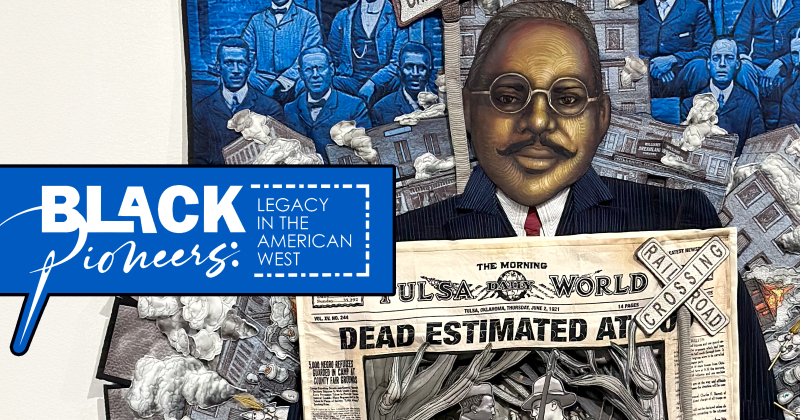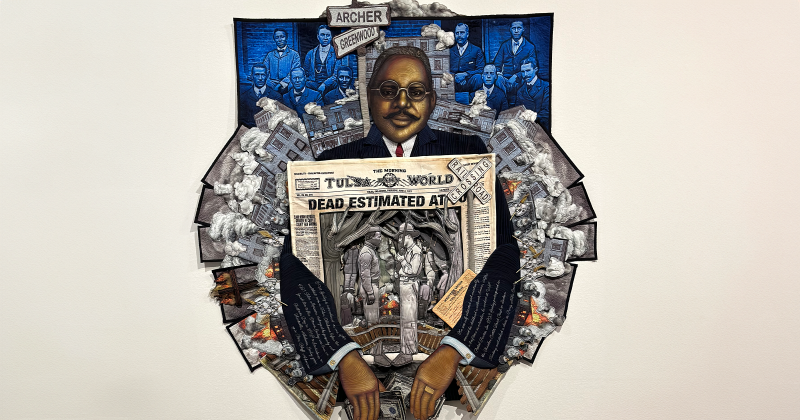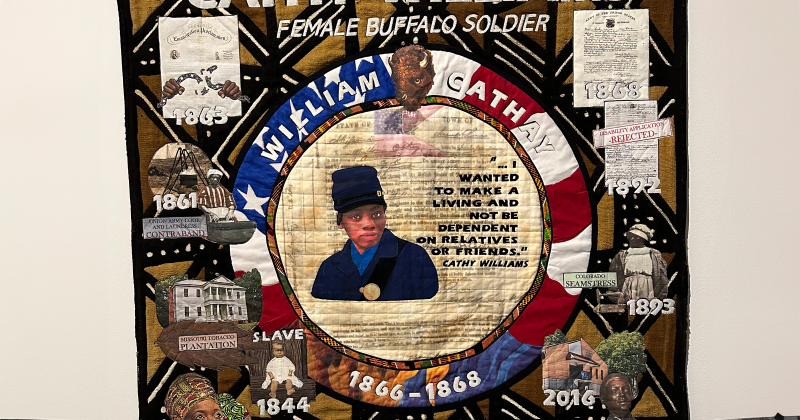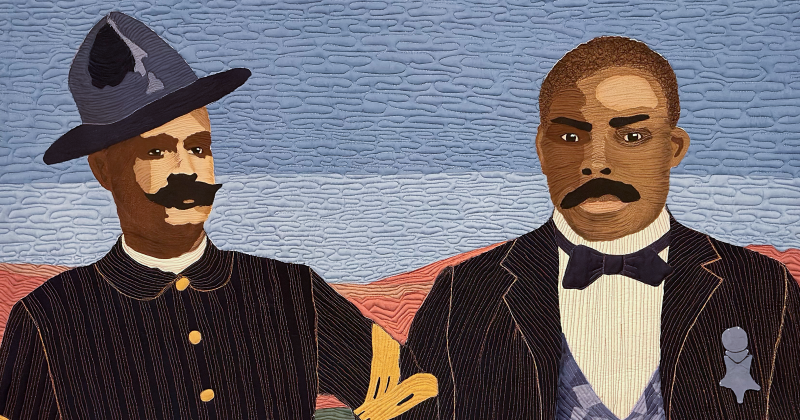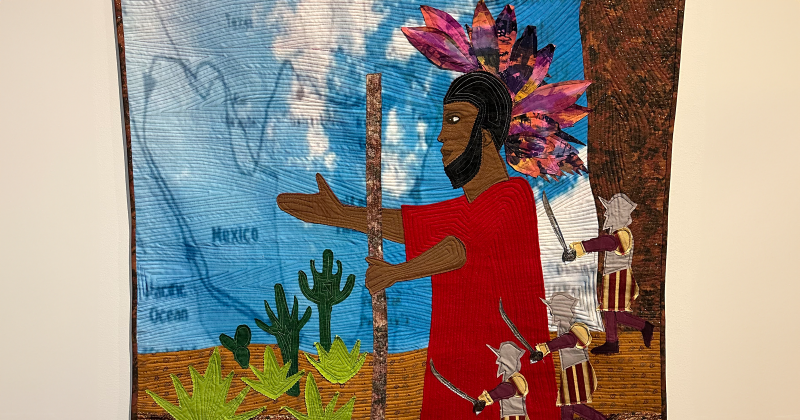The Stark Museum of Art in Orange has an inspiring new exhibition, a first of its kind, which explores the path of Black history in the West with a timeline of original pictorial quilts. The timeline begins in 1528, with Esteban’s dramatic story, which marks the arrival of Africans in the American West and continues through the Civil Rights Movement.
“This is the first time the Stark Museum has offered an exhibition of this magnitude featuring not only all African American artists, but all female artists as well,” said Jennifer Dickinson, interim executive director of the Stark Museum of Art. “Among the 50 artists featured, we are also showcasing an art quilt by Tomasita Louviere-Ligons, a Port Arthur native and Lamar University alumna, as well as art from Georgia Williams, who is a Beaumont native. This is a wonderful opportunity to celebrate art, culture and heritage.”
This exhibition, now on display through Aug. 3, is organized by The James Museum of Western & Wildlife Art and Dr. Carolyn Mazloomi, curator, historian and artist. The quilts have been created by the Women of Color Quilters Network especially for this exhibition.
“Why quilts?” asked Mazloomi. “Quilts and quilt making are important to America, and Black culture in particular. The art form was historically one of the few mediums accessible to marginalized groups to tell their own story, to provide warmth for their families, and to empower them with a voice through cloth. Using quilts to tell these stories accentuates the intersections of African Americans in the Western frontier while at once informing about the art form and its role in Black history. It is this often unknown and underappreciated shared reality that must be voiced if we are ever to truly value the unique contributions diverse groups make to the fabric of our nation.”
For the quilt, “Men of Valor – Sergeant Benjamin Brown and Corporal Isaiah Mays,” Louviere-Ligons used hand-dyed cotton fabric, woold and cotton batting, leather, polyester threads, acrylic paint with raw edge appliqué by machine quilting.
“Sergeant Benjamin Brown and Corporal Isaiah Mays are American Frontiersmen who served ‘above and beyond’ in the United States Army’s all-Black Buffalo Soldiers 24th Infantry during the westward expansion into American Indian Territory,” said Louviere-Ligons. “Brown and Mays received the U.S. military’s highest honor of valor, the Medal of Honor, on Feb. 19, 1890, for their heroic actions during the May 1899 Wham Paymaster Robbery in the Arizona Territory.”
Thomazine Alexander and Dena Miskel quilted a piece of art from Georgia Williams, titled “Cathy Williams a.k.a. William Cathay: Female Buffalo Solider.
“Williams, born in 1844, was the first African American woman to join the United States Army,” stated Georgia Williams. “Disguised as a man, she enlisted under the name William Cathay and served as America’s only female Buffalo Soldier from 1866 to 1868. This quilt recognizes this remarkable woman and her mother. While in the hospital, her identity as a female was finally discovered, and she (as William Cathay) was given a disability discharge in 1868. In the early 1890s, having learned of other females (Caucasian) who received army pensions, she repeatedly filed for a disability pension but was denied in 1892. It is believed that Williams died in 1893. In 2016, Cathay Williams was finally recognized as an American heroine in a bronze monument in Leavenworth, Kansas.”
The Stark Museum of Art is also hosting “Black Pioneers: Legacy in the American West” quilt exhibition, featuring renowned Texas artists Carolyn Crump, Barbara McCraw and Georgia Williams inside the Lutcher Theater (707 Main Ave.) auditorium Saturday, March 9, from 2-3 p.m. Immediately follow, an exhibition reception is set for 3-5 p.m. at the Stark Museum of Art.
“The Stitching Stories artist talk will offer attendees an opportunity to delve into the artistic processes, inspirations and personal narratives behind the quilts on display,” said Dickinson.
“These talented artists will share insights into their creative journeys, shedding light on the significance of quilting as a medium for storytelling and cultural expression.”
In addition to the featured quilts, attendees will have the exclusive opportunity to view additional works on display during the artist talk.
This rare glimpse into the artists’ portfolios promises to deepen appreciation for the rich tapestry of stories woven into each intricately stitched piece.
Guests will have the chance to meet the artists and acquire signed copies of the accompanying book, “Black Pioneers: Legacy in the American West,” which offers a comprehensive exploration of the exhibition’s themes and showcases a stunning collection of quilts by Crump, McCraw, Williams, and the other talented artists showcased in the exhibition.
“The Women of Color Quilters are an important group,” said Mazloomi. “Most of our quilts that originate out of our network and originate in the shows have to do with either African American history or some facet of living life here. When people think in terms of quilts, they think in terms of warmth, heart, home and protection. It’s a non-threatening way to tell very difficult subjects that people don’t want to read about them, but they will come to see them in the museum.
“I want the viewers leaving the exhibition knowing that we, as African Americans, have participated in the making of this country since we stepped off the boat – explorers, business people, cowboys – people will see that in the quilts and I think that’s important.”
Located at 712 Green Ave. in downtown Orange, admission to the Stark Museum of Art is free. The museum is open Wednesday-Saturday from 9 a.m. to 5 p.m.


